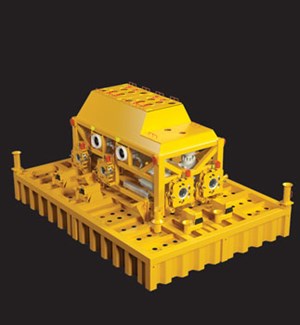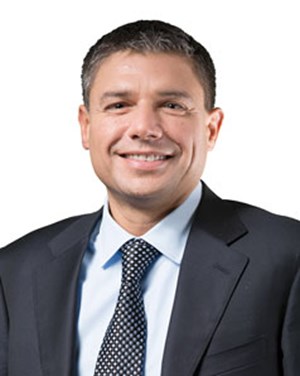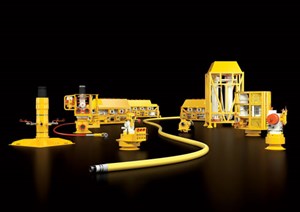Lorenzo Simonelli sees busy year of advancement for BHGE
World Oil (WO): Obviously, the big elephant in the room is that GE said it wants to completely sell its holdings in BHGE. Is there a specific timetable and/or strategy for this process?
Lorenzo Simonelli: Earlier in 2019, GE announced that it would separate from BHGE over time, in an orderly fashion that maximizes value for both companies’ shareholders, customers and employees. In November 2018, we began this process by launching a secondary offering, buying back some of our own stock, and updating and enhancing a series of commercial agreements that define our relationship with GE going forward.
On the offering, GE sold 92 million of its shares on the public market and is not able to sell additional shares for 180 days, per the standard lock-up agreement. We used parts of our existing buyback program to repurchase stock from GE directly at very attractive valuation that is expected to be accretive in 2019. Additionally, we updated and enhanced commercial and technical agreements with GE that provide more clarity on our future and set us up for success.
We are very pleased with the agreements reached with our partners at GE. GE has not communicated the additional steps for the rest of their stake but has committed to orderly processes, as seen here.
WO: Meanwhile, how do you reassure your customers that all will go well with GE’s eventual exit, and keep competitors from trying to take advantage of the situation?
Simonelli: BHGE leverages leading technology, global scale, and an integrated offering to provide full-stream solutions to our customers. For our shareholders, we generate value through synergy execution and generating top-tier shareholder returns through the cycle. We already operate as a separate independent company, and we don’t expect material changes to our operational footprint or our ability to serve customers as we separate.
As I mentioned, a key element of the separation process includes updated and enhanced commercial and technical agreements with GE that preserve and enhance our strategy to deliver a differentiated full-stream portfolio and provide clarity for our employees, customers and shareholders. We are very pleased with the agreements that we have reached with our partners at GE.
We will maintain a close partnership with GE in a number of areas—for example our long-term collaboration on rotating equipment, including aeroderivative and heavy-duty gas turbine technology. BHGE will continue to have access to GE Digital software and technology, and we have agreements in place regarding operations and pricing within BHGE Digital Solutions’ Controls product line. Our ability to execute and provide a differentiated investment opportunity is unchanged, and we remain well-positioned to capitalize on the positive outlook for our industry. The ultimate separation will provide BHGE with more control over our strategic direction, capital structure, and capital allocation.
WO: Looking at the oil field market, what is your outlook for global E&P activity during 2019, now that oil prices have taken yet another tumble?
Simonelli: We are encouraged by the improved outlook for the macro environment and see strong opportunities globally. We expect the North American and international markets to grow next year, with customers increasing spending, and overall rig and well counts growing. We see continued momentum in the Middle East, although pricing remains tough. We also see some pockets of activity in Latin America. Sub-Saharan Africa and Asia-Pacific remain challenging, but the offshore market, overall, is the strongest it has been in many years.
We’re seeing some interesting movement, such as the narrowing of the traditional cost gap between offshore and onshore developments. The key is to remember the important lessons we learned during the downturn, which means focusing on enhancing productivity, driving efficient operations, and new commercial approaches that drive long-term value.
WO: How does your assessment of the global upstream market translate into demand for equipment and services during 2019?
Simonelli: For our Oilfield Equipment segment, the outlook is improving. It has been moving steadily in a positive direction, and we secured several wins across our OFE portfolio during third-quarter 2018, including our first newbuild blowout preventer order since 2014. Some of that improvement comes from our ability to offer the kind of flexible partnerships and payment models that certainly enhance our technology offering, but also drive better, more sustainable economics for operators.
WO: Your company talks about being “the world’s first and only full-stream company.” What does that really mean, and how is it implemented?
Simonelli: Fullstream means we can combine leading technology, global scale, and integrated offerings from upstream, midstream, downstream and digital, to deliver productivity solutions. Our integrated offerings create more value by reducing the number of interfaces, as we deliver projects and services. We are also focused on building stronger partnerships with our customers. We enhanced the fullstream vision by creating a financing capability within BHGE this year, with a team dedicated to customer, project and reserves financing. This enables BHGE to partner with customers on innovative commercial solutions that allow projects to move forward—a clear competitive advantage.

WO: What are your company’s strongest areas of technical expertise?
Simonelli: I would not single out one particular area, segment or family of technologies. The combination last year of GE Oil & Gas and Baker Hughes Inc. created a truly unique company that serves every segment of the global oil and gas industry; in upstream with drilling, evaluation, completions and production, and subsea solutions (Fig. 1); in midstream with solutions for LNG, pipeline and storage; and in downstream with refining, petrochemical and fertilizer processing solutions.
Our technologies have won multiple industry accolades including, most recently, at the World Oil Awards, where our lightweight compact tree and our Intelligent Injector Control System won the Best Deepwater Technology and Best Well Intervention Technology Awards, respectively. And we are true leaders of the LNG market, with more than 400 Mpta of globally installed LNG capacity, relying on our turbomachinery, over 30 LNG plants being driven by BHGE gas turbines, and more than 100 LNG trains currently in operation, under construction or awarded.
WO: Are there any technical areas in which you would like to see the company do better?
Simonelli: As a company, I think we’re in an incredibly strong place technically, and that has increased by an unprecedented degree since we formed BHGE last year. Our customers, partners and competitors, and the industry, as a whole, recognize the strength and breadth of our capabilities and the deep-domain expertise of our people. Of course, we’re also continuing to enhance and grow our capabilities and offerings with investment in R&D, and through the exciting new partnerships we’re forming with digital and tech experts outside of the oil and gas space. Important advancements are happening right now in terms of A.I. and predictive analytics.
WO: What are some technical challenges that the industry faces in onshore projects, either shale or conventional?
Simonelli: The “easy oil” has disappeared in onshore projects. Drilling is becoming more challenging, and reservoir targets are getting smaller and more precise. That requires a combination of rotary steerables, formation evaluation, and reservoir navigation services to land the well in the target zone.
We know our land-based customers are interested in managing risk better by simplifying their operations and integrating disparate technologies. We see the benefits of such integration in the Marcellus and Utica shales of the northeastern U.S. where we have set many ROP records and drilled more than 200 “mile-a-day” wells. At the same time, maximizing recovery rates continues to be a top technical challenge. With today’s economics, 15%-to-20% recovery rates are not good enough. We are focused on helping our customers optimize production from existing wells and maximizing production revenue.
Data is key—our competitive advantage comes from us having more of it—both about the wells and the equipment in the wells—than ever before. You have to be able to leverage that data, and we are working with customers to develop customized production plans, backed by real-time monitoring solutions that allow on-the-fly adjustments and continuous production rate optimization.
WO: What are some technical challenges in moving offshore projects forward, particularly in deep water?
Simonelli: Production of oil and gas from subsea wells is arguably the most complex activity in E&P. The technical challenges haven’t changed dramatically over the past few years. They very much center on the difficult operating environments and complex nature of subsea reservoirs, including deepwater installation; long offsets and narrow weather windows; HPHT wells; highly corrosive fluids; and associated flow assurance challenges.
We have more than 100 years’ experience in devising solutions to meet those challenges in this segment. We delivered the industry’s first subsea 15,000-psi-rated tree, and our subsea wellheads have been installed at water depths of over 3,000 m, while our SemStar5 has a world-leading 150-year mean time between failures, or 10 times the industry average. Gas projects are becoming increasingly attractive, which has led to some major business wins this year, including Gorgon Phase 2, Shwe and ONGC 98/2.
WO: BHGE recently introduced subsea systems than can reduce the economic development point of projects by 30%. Can you elaborate on how this is achieved?
Simonelli: There is no “silver bullet” for improving efficiencies. Subsea Connect combines the latest subsea technologies that are lighter-weight and have been designed with life-of-field in mind, and a project management system that streamlines the whole design, engineering and delivery process. That’s coupled with cutting-edge digital applications and innovative commercial models. Looking at the work we are doing with Nexen in the UK North Sea for the Buzzard project’s second phase, BHGE is part of an integrated project team that consists of multiple suppliers, working under an incentivized, outcome-based commercial model at Nexen’s offices in Aberdeen. It’s an unconventional approach, designed to streamline execution and shows how far our industry has come, as regards collaboration.
Technology is fundamentally important, too, and our Aptara technologies (Fig. 2) offer big changes in cost, weight, size and modularity, which impacts how the equipment is manufactured, delivered, installed and operated. That enables a significant reduction in expenditure across the total life of field.
WO: Does BHGE have its own technical R&D priorities?
Simonelli: We continue to invest in developing new technologies that support our customers and provide stronger, more valuable outcomes. An important focus that I would highlight is our commitment to partnering with industry to drive advancements at a much greater speed and scale. Working together on the development of new technology means customers get fit-for-purpose solutions they need, rather than all the bells and whistles that the service company hopes they want. Operators are making major efforts to address the challenge of lowering the carbon footprint of their operations, and this is one way in which we are supporting them to achieve their goals. For example, we have carried out pilot programs using drone technology for methane inspection, and we have the largest, most complete testing capability in the industry to perform tests under actual load and pressure conditions, including LNG and re-injection.
WO: Saudi Aramco just awarded your firm a major well services contract for conventional fields in Saudi Arabia. What does it entail?
Simonelli: It is an exciting, strong example of what I mentioned earlier—how we are uniquely positioned to partner with our customers. We are working with Saudi Aramco to optimize production from new and existing wells across conventional fields in the Kingdom. We will deliver a comprehensive well services solution that includes all cased-hole wireline logging, perforation, well testing, stimulation, fracturing and associated intervention services. It’s our ability to integrate products, services and capabilities into a single offering that is helping Saudi Aramco to reduce time, costs and complexity of operations, all the while increasing efficiency.
WO: The Permian basin seems to be the gift that keeps on giving. Do you see any slowing down, at all, of activity in the region during the next several years?
Simonelli: The North American market continues to be resilient, and we expect continued growth with short-term bottlenecks. Drilling-related activity remains stable, which bodes well for our portfolio. We are focused on expanding our presence across North America, The Permian is an important basin for us, but we also have a significant presence in other key basins, such as the Marcellus, Bakken and Eagle Ford.
WO: By contrast, the offshore sector, particularly the U.S. Gulf of Mexico, is struggling. What are the chances for a meaningful recovery, and when?
Simonelli: Although the oil price drop undoubtedly created big challenges for the industry, it also stimulated important, meaningful efforts to improve the competitiveness of offshore and subsea, creating an environment where alternative solutions are increasingly welcome. Standardization, project design optimization, simplification and direct supplier cost efficiencies—all of these have lowered average development costs more than 35% in greenfield developments, and 23% in brownfield developments.
WO: Where would you like to see BHGE positioned, four or five years from now?
Simonelli: I think our greatest opportunity now, and in the coming years, is to redefine the productivity possible through closer collaboration across the value chain, and leveraging technology innovations and integration across projects. This is really around stronger partnerships with our customers, our suppliers, and within our own teams.
WO: What are your greatest challenges in serving as Chairman and CEO over the next year?
Simonelli: Look, none of us has a crystal ball. The geopolitical situation is always changing, and that will always bring uncertainty on an almost daily basis, which is why our approach is to stay nimble and flexible. That helps us navigate the short term, and to be there for the long term. My focus is on ensuring the company continues to execute strongly and delivers on promises to
our customers.
WO: What do you find most gratifying about serving in this role?
Simonelli: The vision for our business is clear and simple: Inventing smarter ways. That focuses and drives us, and it is immensely satisfying when we see the difference that mindset makes to our customers’ operations, and the gains they realize through their partnership with BHGE. That’s made possible by the commitment and dedication of our amazing teams, and we have the best people around! It is always so rewarding to visit our people, spend time with them and talk about what they are working on and what drives them. Their enthusiasm and passion are incredible! We have also made some major product advances on our journey in 2018. These are things that make BHGE so special. ![]()

- Annular safety valves advance flexibility, reliability and safety in completion operations (July 2024)
- Rethinking sand management for optimized production (June 2024)
- Can an offshore drilling rig run on green methanol? (May 2024)
- Reducing conservatism and increasing service life of subsea BOPs with novel strain sensor (December 2021)
- Well control surface intervention that is inclusive of environmental preservation (December 2021)
- Manifold destiny: A new blueprint for a changing world (December 2021)




